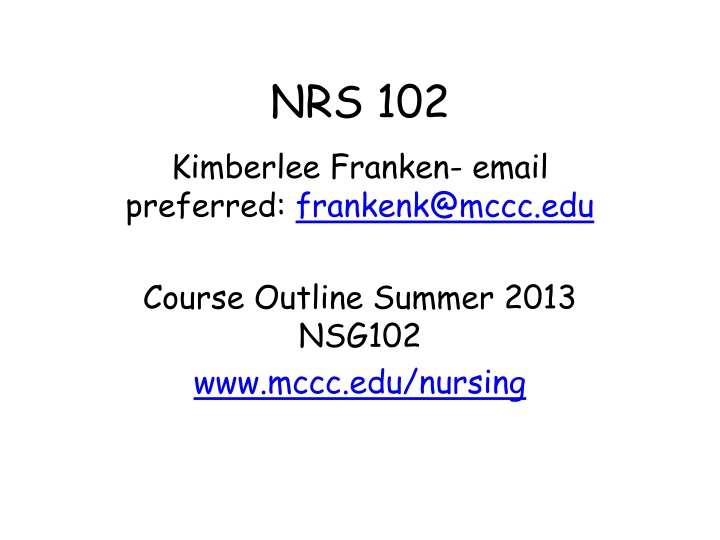
Nursing Course Learning Objectives and Success Strategies
Explore the essential learning objectives of a nursing course focusing on assessment, cultural competence, and client diversity. Gain insights into effective study techniques and stress management for success in nursing education. View tips for time management and pre-planning to excel in your studies.
Download Presentation

Please find below an Image/Link to download the presentation.
The content on the website is provided AS IS for your information and personal use only. It may not be sold, licensed, or shared on other websites without obtaining consent from the author. If you encounter any issues during the download, it is possible that the publisher has removed the file from their server.
You are allowed to download the files provided on this website for personal or commercial use, subject to the condition that they are used lawfully. All files are the property of their respective owners.
The content on the website is provided AS IS for your information and personal use only. It may not be sold, licensed, or shared on other websites without obtaining consent from the author.
E N D
Presentation Transcript
NRS 102 Kimberlee Franken- email preferred: frankenk@mccc.edu Course Outline Summer 2013 NSG102 www.mccc.edu/nursing
Advice for Success Know your Course Outline Familiarize yourself with program information Pre-plan and have Plan B in place Time Management Stress Management
Week 1 Learning Objectives 1. Define and describe the meaning of assessment and the different types of assessments. 2. Describe and discuss how cultural and religious differences and preferences may affect an individual s lifestyle and health care choices. 3. Describe the importance of the nurse s self knowledge regarding prejudgment and bias related to culture and diversity. 4. Differentiate between cultural sensitivity and cultural competence. 5. Describe why information obtained during a cultural assessment interview is of value.
Learning Objectives (contd.) 6. Identify factors that contribute to diversity. 7. Contrast the diverse needs of various groups of clients/patients based on race, age, gender, sexual orientation, and membership in a vulnerable population. 8. Differentiate between the terms growth and development , and the significance of both to health assessment. 9. Describe factors that influence both growth, and development. 10. Recognize major development milestones for clients/patients across the lifespan.
Learning Objective #1 1. Define and describe the meaning of assessment and the different types of assessments. WE ASSESS THINGS AND PEOPLE ALL THE TIME (YOU ARE ALL ASSESSING ME RIGHT NOW!)
1stStep in Nursing Process is Assessment
Assessment defined: The evaluation or estimation of the nature, quality, or ability of someone or something.
Assessment described: Initial assessment interview identifies cultural behaviors, health beliefs, illness practices, and cultural needs. (This information is helpful in planning culturally sensitive care.)
Learning Objective #2 Cultural and religious differences may affect an individual s lifestyle and healthcare choices
Learning Objective #3: It is important for the nurse to have self knowledge about pre judgment and bias related to culture and diversity.
What does culture have to do with health care ? Cultural patterns are learned by people living together in a society. Culture influences the customs, beliefs, and values about wellness, health, illness, birth and death.
Learning Objective #5: Information obtained during a cultural assessment interview is of value.
Learning Objective #3 Describe the importance of the nurse s self knowledge regarding prejudgment and bias related to culture and diversity. and why should I care?
Male dominated culture What is the best way to handle this when possible?
What if your patient is from a different culture than your own, speaks another language, and doesn t make eye contact with you? Do you get another nurse who is of the same culture? Do you wait and come back later?
Figure 6-1 (continued) Different cultural heritages are parts of the population in America. Source: Graph from U.S. Bureau of the Census. (2007). State & County QuickFacts. Retrieved from http://quickfacts.census.gov/qfd/states/00000.html; Steve Vidler/SuperStock; Robert Caputo/Stock Boston; Arvind Garg/Getty Images, Inc. Liaison. (Text, pg. 324). So, what do you think?????
Diversity What is your definition of diversity?
Learning Objective # 6 Diversity defined: Unique variations among and between individuals, as well as those defined by genetics and cultural background, but are refined by experience and personal choice. (Text, pg. 398).
Factors contributing to diversity include: Age Gender Sexual Orientation Socioeconomics Living Arrangements Race Culture Education Life Experiences
Growth vs. Development
Growth: Physical change and an increase in size. It can be measured quantitatively.
Development: An increase in the complexity of function and skill progression, the capacity of skill and a person to adapt to the environment. *** Development is the behavioral aspect of growth (e.g., a person develops the ability to walk, to talk, and to run.)
Factors that influence both growth and development: Genetics Prenatal Influences Environmental Influences Cultural Influences Nutrition Family and Parenting Health
